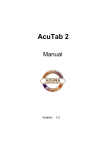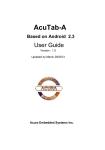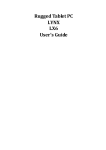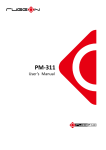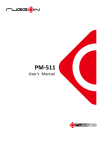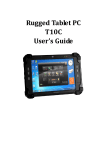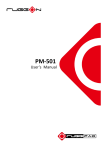Download Acura Embedded AcuTab-M7 User`s guide
Transcript
AcuTab-M7 Features • • • Rugged Tablet PC User’s Guide • • • • • • • • • • • • Platform: Intel® Cedar Trail Platform (N2600+NM10) GPU: Intel ATOM N2600 1.6GHz Dual core Chipset: Intel® NM10 Express Chipset System Memory: 2GB DDRIII 800 SO-DIMMM Storage: 1 x 32G SATA Slim Half-Size Solid State Disk LCD Panel: 7-inch LED Backlight Screen 7“ XGA (1280x800) 400nits LCD, or 500nit Touch Panel 5-wire Resistive Touch Screen Audio: -1 x High Quality Speaker (2W) -Internal Microphone : 1 x in front Bezel TPM: 1x Compatible with TPM1.2 (option) Communication : 10/100Mbps Ethernet Wi-Fi IEEE 802.11 a/b/g/n ; Bluetooth 4.0 GPS Positioning: GPS/QZSS, GLONASS 50 channel all-in-view tracking Webcam: Front - 2 Mega-pixel Camera Rear - 5 Mega-pixel Camera with LED Flash light External I/O: 2 x USB 2.0 (type-A), 1x Micro SD slot, 1x RS232 Power Adapter : AC Input, 100V ~ 240VAC, 50~60Hz DC Output, [email protected], 65W Battery Internal Battery - Smart Lithium Polymer Battery, 2900mAH, 7.5V Mechanical & Environmental • • • • Acura Embedded Systems Inc. Physical Characteristics : Dimension & Weight : 225 x 168 x 26.5mm ; 850g Rugged Design Drop : 5ft drop Vibration : Operating : MIL-STD-810G Method 514.6 Category 4 Fig 514.6C-3 Mechanical Shock : Operating : 20g, 11ms, Terminal sawtooth Non-operating : 40g, 11ms, Terminal sawtooth Water/Dust Resistance : IP65 Environment : Operation temperature : -20°C to +50°C Storage Temperature : -30°C to +70°C Humidity : 5-95% without condensation 1 Optional: Internal Module • • • • 3.5G Sierra MC8355 Gobi3000 : Protocol : HSUPA/HSDPA/UMTS/EVDO/EDGE Frequency : UMTS/HSUPA/HSDPA 850/900/1800/2100MHz CDMA/EVDO 800/1900MHz GSM/GPRS/EDGS 850/900/1800/1900MHz LTE Sierra MC7700/MC7710/MC7750 Optional : External Accessories External Battery Kits : External Battery Pack : Hot-swappable Lithium Polymer battery pack -doubles duration of mobile operation, 4200mAh (2S1P), 7.4V External Battery Charger : Recharges external battery pack MSR : Reference Standards : ANSI/ISO Standards 7810,7811-1/6, 7813 JIS II Decoding Method : ISO Track1 - IATA , Track2 - ABA and Track3 –THRIFT Barcode Scanner : Decoded Mode : • 1D Symbologies : EAN/UPC, RSS, Code 39, Code 128, UCC/EAN 128, ISBN, ISBT, Interleaved, Matrix, Industrial and Standard 2 of 5, Codabar, Code 93/93i, Code 11, MSI, Plessey, Telepen, postal codes. • 2D Symbologies: Data Matrix, PDF417, Micro PDF 417, Maxicode, QR, Aztec, EAN.UCC composite. Viewing AcuTab-M7 Before starting to set up AcuTab-M7, get familiar with the locations and purpose of controls, connectors and I/O ports, which are illustrated in the figures below. When placed upright, the front panel of AcuTab-M7 appears as shown in below. 2 3 Camera / 2 Mega-pixel (Front-facing) The built-in camera can be used as a communication device for allowing you to capture images, record videos, and have video chats. It is 2M pixels and can be used for transmitting live image through network for video conference. Camera / 5 Mega-pixel (Rear-facing) The built-in high resolution camera can be used as a communication device for allowing you to capture images, record videos, and have video chats. Power / Storage / RF status LED Indicator Keeps you informed of your system’s current power status, storage access status, and RF wireless devices ON/OFF status. Switch the computer power on and off, or resumes whenever it is in Suspend mode (by OS define). USB Ports The two USB (type-A) ports allows you to connect USB 2.0-compliant devices (for example, mouse, keyboard and so on) to your Tablet PC. 3.5mm Headphone Jack Allows you to connect an external 3.5mm 4-conductor TRRS (stereo-plus-mic) headphone for personal listening and sound recording. Micro SD Card Slot The Micro SD (SDHC) card slot allows you to transfer/record video and pictures to your tablet, while adding extra storage capacity. Ethernet Port The 10/100Mbps Ethernet port allows you to connect to other computers/networks through a local area network (LAN). RS-232 Serial Port RS-232 serial port allows connections to modems, printers, mice, barcode readers, data acquisition equipment, and other peripheral devices. Accessory Door By removing the two long screws on top side of the system, allows you to install optional snap-on module. External Battery Connector To install the external battery pack, install external battery holder first and remove the cover of external battery connector before snap the battery pack into the external battery connector. Speaker Integrated stereo speaker for sound and audio output for your multimedia presentations or listening pleasure. Protective Rubber To prevent system harm from vibration or shock, the system is designed with installing protective rubber on four corners. Programmable Function Buttons (F1~F4) These buttons is programmable to execute specific software application. When you program the application to launch, please write this directory as listed below into the configuration file, then the system will aware and execute this application. 1. RF ON/OFF 2. Storage Access 3. Power LED Indicator RF ON/OFF Indicator When LED turns on, white LED indicates that a wireless device (Wifi / Bluetooth / WWAN) is activated. When LED turns off, it indicates that all RF devices are being disabled. Storage Access When LED blinking white indicates that the system is accessing the internal storage drive. Power LED Indicator Letting you know that system is turned on and indicate the battery charging status. Lights green when the system is powered on and battery is discharging Lights amber when the system is powered on and battery is charging Lights blinking amber when the system is in S3 sleep mode and battery is charging or lights blinking green when the system is in S3 sleep mode and battery is fully charged Lights off when system is powered off or the battery is fully charged. Power Button 4 5 [Setup] F1_EXE="c:\windows\explorer.exe" F1_PARA="" F1_PATH="" F2_EXE="C:\Program Files\Windows Media Player\wmplayer.exe" F2_PARA="/prefetch: 1" F2_PATH="" F3_EXE="C:\WINDOWS\system32\osk.exe" F3_PARA="" F3_PATH="" F4_EXE="C:\WINDOWS\system32\taskmgr.exe" F4_PARA="" F4_PATH="" The configuration file is located under drive C: root directory as "c:\FKeySet.txt" Trigger Buttons (F1 / F4) Please press F1 or F4 function keys to trigger to scan the barcode when the optional barcode scanner snap-on module is installed. If your system does not install this module, these buttons can be programmable to execute specific software application. When you program your application, please write this directory as listed below into your configuration file, then the system will aware and execute this application. F1_EXE="c:\windows\explorer.exe" F1_PARA="" F1_PATH="" F4_EXE="C:\WINDOWS\system32\taskmgr.exe" F4_PARA="" F4_PATH="" DC-Jack Lets you connect the AC power adapter in supplying continuous power to your Tablet PC and recharging the battery. The AC adapter provides external power source to your system and charges the internal battery pack at the same time. The AC adapter also has an auto-switching design that can connect to any 100VAC ~ 240VAC power outlets. To connect the power adapter: 1. 2. Plug the AC adapter connector to the DC-Jack socket on the left side of the system. Plug the power cord to the AC adapter. Plug the other end of the power cord to a live wall outlet, at the same time, the Power LED at front panel lights up. -- For the power supply of this equipment, an approved power cord has to be used. -- Make sure the socket and any extension cord(s) you use can support the total current load of all the connected devices. -- Remove all power from the device prior to installing or removing any accessories, hardware, or cables -- Before cleaning the system, make sure it is disconnected from any external power supplies (i.e. AC adapter). Docking Connector Lets you connect the system to docking station to dock the tablet PC when you are at home or office desk. Using the Hotkey Utility Application AcuTab-M7 has numbers of applications on the control panel for executing specific command. It provides you to adjust brightness, volume, launch webcam, switch monitor (via docking) and RF device ON/OFF. This user interface provides specific mobile utility to let you easily setup some helpful functions and aware the system status directly. This utility also let you adjust some function to fit the requirements, such as brightness and volume adjustment, webcam launch, monitor switching and RF device ON/OFF. Furthermore, it also provides system information for your reference, such as battery status, RF setting with its signal strength, firmware (BIOS & EC) version information. Besides these features, you can press the soft button to hibernate this system. About the User Interface Enable or disable the User Interface To display the User Interface, please press the Fn button or point the Hotkey Utility icon located on Windows desktop. To close the User Interface function, please press the X button on the top right corner on 6 7 this User Interface for disabling this utility from the screen. If there is no action within this utility in 5 seconds, the UI screen will close automatically. If the system installs both the 1st internal battery and 2nd optional battery, the illustration shown below indicates its current charging status and capacity. If 1st battery capacity drops to 15%, the system will display the following warning message for 5 seconds. System Status Information For RF status: The following RF status shows you that the system is equipped with Wi-Fi, and Bluetooth functions. If you want to close either of these functions, please refer section for how to disable it. This utility shows you the battery capacity status, RF status with its signal strength and system information, and provides the control panel for the function setting. For battery capacity status: The following signal strength shows you that the Wi-Fi function is connecting currently, the stronger the signal strength, the more scale will show on the bar. If there is no module in the system, there will be no status scale in the following status bar. AcuTab-M7 is equipped with one internal battery and one optional external battery. The system information shown on the left shows you the hotkey utility version, BIOS and EC version and you can use them for customer service when asked. The battery capacity status shown below advises you, that only one internal battery is nd embedded with the system which is fully charged, and there is no 2 optional battery installed in the system. For System Information : 8 9 Brightness Control For brightness adjustment, press the Brightness icon. You can click or to reduce or increase the audio volume incrementally. When you press it, the brightness control panel is appeared as follows: Also, you can slide the scale bar You can tick the Mute to set the audio volume. to mute the audio. Launch Webcam Utility For Webcam Launch, press the Webcam Or can access the Webcam You can click Also, you can slide the scale bar or icon to launch the Webcam utility. icon located on desktop. to reduce or increase the LCD brightness. to set the brightness. Volume Control For Volume adjustment, press the Volume icon. Monitor Switch to pop-up the selection bar four options. the Monitor For monitor switch, press Switch for choosing the display mode within following. When you press it, the Volume control panel is appeared as follows: 10 11 Press this soft button (via hotkey utility menu) to enable or disable Wi-Fi, Bluetooth, WWAN, or GPS devices. When you press the RF ON/OFF soft button, the screen pops-up the option list for your selection. • • • • You can click Duplicate to display the same contents both on the screen and external display device. The resolution on these two display modes are same, it is not available to adjust the resolution on the external display mode. You can click Extend to display the different contents on the screen and external display device. You only can adjust the resolution on the external display device. You can click Projector only projector/monitor only. You can see all functions in this option list have been ticked. To close any device function, please touch the option to close the execution as shown in the following graphics. Disable Wi-Fi function Disable Bluetooth function Disable WWAN function Disable GPS function to display on external RF Device ON/OFF Control 12 To activate the function, please again tick the option as shown in the following graphics to make the device enable. 13 Before setting up the system, please make sure the following items are available. Keyboard Mouse (for system software installation) A keyboard is an input device; a mouse is a pointing device. Please connect these two devices as graphics shown below to interact with your system. Using the External Audio System At the right side of AcuTab-M7, you will find the headphone jack for connecting 3.5mm 4-conductor TRRS (stereo-plus-mic) headphone jack. Bios Setup Program This system comes with a chip from Phoenix BIOS that contains the ROM Setup information for your system. (This chip serves as an interface between the processor and the rest of the system components.) This section explains the information contained in the Setup program and tells you how to modify the settings according to your system configuration. Activate Wi-Fi function Activate Bluetooth function The Setup utility program allows updates to the main board configuration settings. The BIOS setup values will be saved in the CMOS. It is executed when you change the system configuration, you change the system backup battery, or the system detects a configuration error and asks you to run the Setup program. You must have connected a USB type of keyboard, and Use the arrow keys to select, and press Enter to run the selected program. Function Key Please check the following table for the function description of each direction key. Activate WWAN function Activate GPS function Function Key (s) Function Description Moves cursor left to select Screens / Powering on for the first time The Power/Resume button is found on the left side of the Tablet PC. Press the Power/Resume button to start your system and check that if the Power LED turns on. After a few seconds, the system’s display to execute the Power On Self Test or POST to check if all system components are running properly. Any error found during the test will be displayed on the screen. After the test, the screen will also display a message "press <F2> to enter SETUP". You don’t need to run this program at the the necessary settings for your computer optimal operation. After the test has completed, your computer will start to search and boot up the operating system from your hard drive. 14 Moves cursor up or down to select items +/- To change option for the selected items <Tab> To bring up the selected screen <F1> To display the General Help screen <F10> To save changes and exit the BIOS SETUP UTILITY <ESC> To jump to the Exit Screen or exit the current screen Main Screen Setup Utility When you enter the BIOS SETUP UTILITY, the Main screen will appear and display the system overview. 15 The system will automatically displays the information of Total Memory. Advanced BIOS Features For Advanced Settings, it lets you define the device configuration when system booting. The Standard CMOS Setup screen is displayed above. Each feature may have one or more option settings. Use the arrow keys to highlight the feature you want to change and then use “ ”or “ ”to select the value you want for that feature. NOTE: The system BIOS automatically detects BIOS, Processor, memory size, thus no changes are necessary. System Date To set the date, highlight the Date field and then press +/- keys to set the current date. Follow the month, day and year format. System Time To set the time, highlight the Time field and then press +/- keys to set the current time. Follow the hour, minute, and second format. BIOS Version The system will automatically displays the information of BIOS version. Build Time The system will automatically displays the build time of BIOS. EC Version The system will automatically displays the information of EC (Embedded Controller) firmware version. VBIOS Version The system will automatically displays the information of VBIOS version of internal graphics. Board Version The system will automatically displays the information of PCB version of mainboard. Processor Type The system will automatically displays the information of Processor Type and speed. System Memory Speed The system will automatically displays the information of System Memory Speed. L2 Cache RAM The system will automatically displays the information of L2 Cache RAM. Total Memory 16 Security Configuration • Set Supervisor Password This field let you set or clear the Supervisor Set User Password This field let you set or clear the User account’s password. TPM Support Lets you activate or de-activate the TPM function by selecting Enabled or Disabled option. (For the non-TPM SKU, this item will display “no detected") 17 Boot Management Setup • Exit Saving Changes When you select this option, it will pop-out the following message, “Save configuration changes and exit setup?” Select [OK] to save the changes and exit the BIOS SETUP UTILITY. • Exit Discarding Changes When you select this option, it will pop-out the following message, “Discard changes and exit setup?”. Select [OK] to exit the BIOS SETUP UTILITY without saving any changes. • Load Setup Defaults When you select this option, it will pop-out the following message, “Load optimal defaults?” Select [OK] to load the default values for all the setup configurations. • Save Changes When you select this option, it will pop-out the following message, “Save changes?” Select [OK] to save all changes. This page allows you to set the search drive sequence where the system will try to boot up first. To select the boot device, you can use the up or down arrow key, then press <+> to move up the device in the list or press <-> to move down the device in the list. To exit from this menu, press <Esc>. Technical Support With the unique set of products, Acura Embedded Systems remains committed to its goal of providing trouble-free and customer-friendly service. A special customer service unit has been set up specifically to cater to our esteemed customers' needs. Exit Control contact your Salesperson or [email protected] Mailing address: Acura Embedded Systems Inc. Unit #1, 7711-128th Street, Surrey, BC V3W 4E6, CANADA Ph: (604) 502-9666 Fax: (604) 502-9668 Toll Free 1-866-502-9666 18











